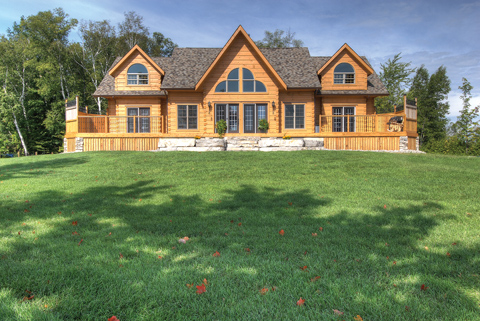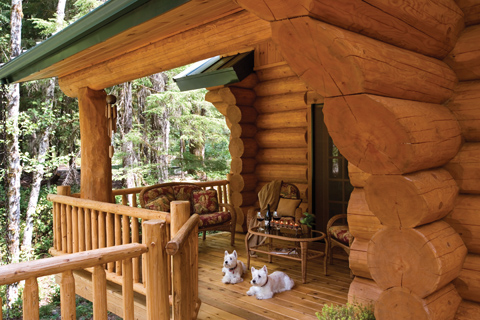When planning your perfect log cabin home, there are many decisions that must be researched. Whether you are contemplating the idea of a log home or beginning the design process, the end result can vary greatly depending on the multitude of choices made. The choice of wood species is one of the biggest and first decisions to make. Next, you must consider corner styles or joint methods, chink or no chink, and which drying method best suits your needs. You also need to learn the difference between milled and handcrafted logs, and what type of log profile has the most aesthetic appeal. There’s no right or wrong, it’s all just a matter of preference. Here is some information to help you get started on your quest toward deciding on the look.
Most Popular Wood Species
Eastern White Pine: Plentiful in North America, Eastern white pine is known for its height, ruggedness, durability, and low shrinkage rate. It is also naturally resistant to decay. When the tree is cut, the wood is a creamy white or pale straw color. If left untreated it ages to a rich tan. The heartwood has a tight grain pattern and minimal knots.
Western Red Cedar: Western red cedar is available in long lengths and large diameters. It is known for its warm, varied coloration, which ranges from a dark red-brown to a light white, and its uniform, fine-grained texture. It has a natural aroma that comes from the thujaplicins in its heartwood; these are also toxic to the fungi and insects that cause decay.
Northern White Cedar: This species is often chosen because of its availability and resistance to rot and termites. It has a fine texture and an even grain. The heartwood is a straw-brown color, while the sapwood is white. Northern white cedar grows to 50 to 70 feet tall.
Cypress: This species is naturally impregnated with cypressene, a preservative oil that makes it resistant to decay. It has a fine texture, beautiful grain, and a natural light color—predominantly yellow tones with hints of red, chocolate brown, and olive.
Douglas Fir: A plentiful species, Douglas fir is available in long lengths and large diameters. It is stable and strong with a straight, fine grain and minimal knots. The heartwood is a reddish brown and the sapwood (latewood) is a light rosy color.
Oak: A hardwood species, oak is strong and durable. It has a dense cellular structure that makes it stable and insect-resistant. It has a rich grain and warm coloration.
Spruce: Known for its long, straight trunks, spruce has a fine grain and a smooth texture. The sapwood is almost white, while the heartwood has a slight reddish tint.
Lodgepole Pine: Often harvested dead-standing, this species has a more rustic look. It has a unique appearance with lots of character and knots. It is known for its “Blue Stain,” which gives the wood blue, black, and gray markings.
Western Hemlock: This species is strong, straight-grained, fine-textured, and nonresinous (i.e., holds stain well). The wood is a white to light yellow color with small knots. It is available in long lengths.
Milled or Handcrafted?
Milled: You can recognize a milled log home by its uniform profiles and log diameters, especially in the corners. The log home producer runs harvested trees or cants through a milling machine, creating logs of a specific profile. Companies often cut tongue and groove or coped fittings into the milled logs to create a tighter seal between logs. According to the Log Homes Council, 90 percent of all modern log homes are milled.
Handcrafted: The logs on a handcrafted home retain the shape and size they had when they were cut. They may be peeled or scraped, but they are not run through a mill. The diameters of the logs in a single home vary on the wall lengths and at the corners. A handcrafted home can look more natural and rustic than a milled log home.
Most Common Log Profiles
Full Round on Round: This profile is also known as Swedish-cope, Saddle-cope, or Round-notch. It can be used on milled or handcrafted homes; the milled version has tongue-and-groove joinery on the horizontal surfaces where the logs meet. Round log diameters range from six inches to a whopping 20 inches. Typically, the profile will be log-on-log, with a Saddle-notch corner style. Chinking on this profile is purely decorative.
Square/Rectangle: This profile used to be common in the Carolinas, Tennessee, and the rest of the South, but now it is seen all over North America. It is characterized by flat interior and exterior walls. The timber sizes for this style range from 6 inches square, to 6×12, 6×14, as well as 8 inches square, 8×12, and 8×14. The most common of these is the 6×12 log profile, also known as the “Traditional” log profile. This profile is often used with a Dovetail or Corner-post design; decorative chinking can be added.
D-Log: This log profile features a rounded exterior and a flat interior. Some log home buyers like the idea of the round look on the outside combined with the ability to hang cabinets and artwork on a flat surface. This profile has gained much success because of the flexibility; one spouse gets the exterior “round” look and the other spouse gets a “flat” surface for decorating and picture hanging on the interior. This profile is typically used in a log-on-log structure.
Double D Log: This profile is similar to the D-Log, but both sides are round, with the top and bottom of the timber being flat or with a tongue and groove fitting. The flat surface on the top and bottom of the timber allows for easy construction. This profile fits easily into both a log-on-log or chink-space design.
Most Common Corner Styles
Dovetail: This style is used with square or rectangular logs. Each log is cut so that it has a fan-shaped wedge at either end; when the logs are stacked these lock together.
Half-Dovetail: This is similar to the Dovetail, except a cut on the top portion of the dovetail has been eliminated.
Swedish Cope: This corner style, a variation of the Saddle-notch, is used on a round log profile. A curve is cut into the bottom of the log so that it securely fits on top of another round log. This style is often used on handcrafted log homes.
Saddle Notch: The name of this design is taken from what it resembles: a saddle. A section of the log is cut out at the corner to fit over the intersecting log, creating a saddle of one log over another.
Butt & Pass: Also sometimes called Mortise and Tenon, this style is common due to its simplicity and builder-friendly design. The name explains the style: One log butts against an intersecting log that passes the butted joint to create an overhang. There are many variations of this corner style.
Post & Beam: This system is more commonly used in veneer applications. A post is positioned at the corner joint, and a section of the post is cut out, so that logs can inset into the post.
To Chink or Not to Chink!
Chinking has been in use since the early settlers began building log homes; then it was necessary to fill in the gaps between the logs. Today, many log home buyers like the traditional look of chinking, whether it is structural or decorative. Usually a chink space includes a spline and gasket, and some log home producers provide a bagged insulation to go into the chink space for more efficiency. Chinking products have improved tremendously over history from mud and mortar to the advanced materials used today that flex, have r-value ratings, and prevent air and water infiltration.
Photography by Roger Wade Studio


